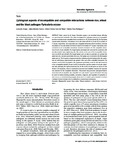Use este identificador para citar ou linkar para este item:
http://www.alice.cnptia.embrapa.br/alice/handle/doc/1044441| Título: | Cytological aspects of incompatible and compatible interactions between rice, wheat and the blast pathogen Pyricularia oryzae. |
| Autoria: | ARAUJO, L.  SOARES, J. M.   FILIPPI, M. C. C. de   RODRIGUES, F. A.   |
| Afiliação: | LEONARDO ARAUJO, UFV; JULIANA MOREIRA SOARES, UFV; MARTA CRISTINA CORSI DE FILIPPI, CNPAF; FABRÍCIO ÁVILA RODRIGUES, UFV. |
| Ano de publicação: | 2016 |
| Referência: | Scientia Agricola, Piracicaba, v. 73, n. 2, p. 177-183, mar./abr. 2016. |
| Conteúdo: | Blast, caused by the fungus Pyricularia oryzae, is an important disease affecting rice and wheat yield worldwide. This study investigated the cytological aspects of incompatible (non-host resistance) and compatible (host resistance) rice- (R_Po) and wheat- (W_Po) Pyricularia oryzae isolate interactions. Inoculations of rice and wheat with the R_Po and W_Po isolates of P. oryzae, respectively, were expected to be compatible interactions (host resistance), whereas inoculations of rice and wheat with the W_Po and R_Po isolates of P. oryzae, respectively, were considered to be incompatible interactions (non-host resistance). For the compatible interactions (rice-R_Po and wheat-W_Po), fungal hyphae penetrated and colonized the epidermal cells and also invaded many neighboring cells. By contrast, in the case of the incompatible interactions (rice-W_Po and wheat-R_Po), fungal hyphae were not able to penetrate nor colonize the epidermal cells, but when penetration did occur, the hyphae were restricted to the first-invaded epidermal cell. The frequency of appressorial sites exhibiting infection hyphae within the epidermal cell underlying an appressorium was greater in the case of the compatible interactions. By contrast, unsuccessful penetrations with cytoplasmic granulation occurred with high frequency in the incompatible wheat-R_Po and rice-W_Po interactions and the number of necrotic epidermal cells underlying the appressorium was low for the rice-W_Po interaction as well as for the wheat- R_Po interaction, where no symptoms of necrosis were exhibited. However, the opposite was observed for the compatible interactions. The present study presents cytological features associated with incompatible and compatible rice- and wheat-P. oryzae interactions that may be useful to studies involving variability, coevolution, diagnosis, and regulation of quarantine or even in a rice or wheat breeding program whose aim is to transfer genes involved in non-host resistance to host resistance due to similarities in downstream mechanisms. |
| Thesagro: | Arroz Oryza sativa Doença de planta Brusone Trigo Triticum aestivum |
| NAL Thesaurus: | Blast disease Magnaporthe oryzae |
| Palavras-chave: | Host resistance |
| Digital Object Identifier: | 10.1590/0103-9016-2015-0169 |
| Tipo do material: | Artigo de periódico |
| Acesso: | openAccess |
| Aparece nas coleções: | Artigo em periódico indexado (CNPAF)  |
Arquivos associados a este item:
| Arquivo | Descrição | Tamanho | Formato | |
|---|---|---|---|---|
| CNPAF2016sa.pdf | 883,85 kB | Adobe PDF |  Visualizar/Abrir |









